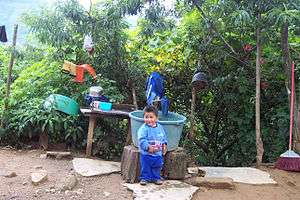Partners In Health
 | |
| Founded | 1987 |
|---|---|
| Founders | Paul Farmer; Jim Yong Kim; Ophelia Dahl Thomas J. White; Todd McCormack |
| Focus | Humanitarian |
| Location | |
Area served | Worldwide |
Key people | Gary Gottlieb, CEO |
Employees | 18,000 |
| Website | http://www.pih.org |

Partners In Health (PIH) is a Boston, Massachusetts-based non-profit health care organization founded by Paul Farmer, Ophelia Dahl, Thomas J. White,[1] Todd McCormack, and Jim Yong Kim in 1987.[2][3]
The goals of the organization are "to bring the benefits of modern medical science to those most in need of them and to serve as an antidote to despair."[4] As such, it provides topnotch healthcare in the poorest areas of developing countries.[5] It builds hospitals[6] and other medical facilities, hires and trains local staff, and delivers a range of healthcare, from in-home consultations to cancer treatments.[7] It also strives to remove barriers to maintaining good health, such as dirty water or a lack of food, and to strengthen the rights of the poor.[8] The approach trades simple charity for “accompaniment,” which is described as a “dogged commitment to doing whatever it takes to give the poor a fair shake.”[9] While many of its principles are rooted in Liberation theology, the organization is secular.[10] It forms long-term partnerships with, and works on behalf of, local ministries of health.[11]
The organization is widely known from Tracy Kidder's The New York Times bestselling book Mountains Beyond Mountains: The Quest of Dr. Paul Farmer, a Man Who Would Cure the World. The book details Farmer's life and work with the organization. The title comes from a simplified translation of the Haitian phrase, deye mon, gen mon.
History
Partners In Health began in 1987, after Paul Farmer and Ophelia Dahl helped set up a community-based health project in Cange, Haiti, known as Zanmi Lasante ("Partners in Health").[12] The organization initially focused on treating people with HIV/AIDS in rural Haiti. PIH now embraces a holistic approach to tackling disease, poverty, and human rights[13] in a variety of countries.[14]
In 1993, Farmer used the proceeds from his John D. and Catherine T. MacArthur Award to create a new arm of Partners In Health, the Institute for Health and Social Justice. Its mission is to analyze the impact of poverty and inequality on health, and to use these findings to educate academics, donors, policy makers, and the general public. Dr. Joia Mukherjee, PIH's Chief Medical Officer,[15] directs the Institute.
Current work
Partners In Health's work is unique in many ways. It collaborates closely with Harvard Medical School[16] and the Brigham and Women's Hospital.
At the invitation of local governments, it strengthens and sustains public health systems in remote, rural areas. It trains and hires local healthcare workers,[17] many of whom actively find patients in their communities and help them get care. It helps local experts conduct academic research that leads to clinical innovation.
Famous supporters include Madonna,[18] Meryl Streep,[19] Ryan Lewis,[20] and Win Butler[21] and Régine Chassagne of Arcade Fire.[22]
Haiti
Zanmi Lasante (“Partners In Health” in Haitian Creole) is PIH’s flagship project. The small community clinic that first started treating patients in the village of Cange in 1985, has grown into the Zanmi Lasante (ZL) Sociomedical Complex, featuring a 104-bed, full-service hospital with two operating rooms, adult and pediatric inpatient wards, an infectious disease center (the Thomas J. White Center), an outpatient clinic, a women’s health clinic (Proje Sante Fanm), ophthalmology and general medicine clinics, a laboratory, a pharmaceutical warehouse, a Red Cross blood bank, radiographic services, and a dozen schools.
The organization has also expanded its operations to 11 other sites across Haiti's Central Plateau and beyond. Today, ZL ranks as the largest nongovernmental health care providers in Haiti – serving a catchment area of 4.5 million. ZL employs over 5,700 people, almost all of them Haitians, including doctors, nurses and community health workers.
Community-based models
PIH's community-based model has proven successful in delivering effective care both for common conditions like diarrhea, pneumonia, and childbirth that often prove fatal for Haiti’s poor and malnourished, and for complex diseases like HIV and tuberculosis. A key to this success and to the PIH model of care pioneered in Haiti has been training and hiring thousands of accompagnateurs (community health workers). The PIH model of accompagnateur care is outlined in the 5-SPICE framework, a scholarly article detailing the tenets of a successful community health worker program.[23]
The use of accompagnateurs is one of the most effective ways of removing structural barriers that prevent adequate treatment of HIV and other chronic diseases while increasing job growth in communities that desperately require employment to further benefit the social structure of the community. Focusing on minimizing the implications of structural violence is the key to the PIH model's success and to the improvement of treatment of chronic disease in rural Haiti.
Expansion in Haiti

As ZL has expanded, it has partnered with other nongovernmental organizations and the Haitian Ministry of Health to rebuild or refurbish existing clinics and hospitals, introduce essential drugs to the formulary, establish laboratories, train and pay community health workers, and complement Ministry of Health personnel with PIH-trained staff. Clinics that previously stood empty now register hundreds of patients each day across twelve sites—Cange, Boucan Carré, Hinche, Thomonde, Belladère, Lascahobas, Mirebalais, and Cerca La Source in the Central Plateau plus additions in the Artibonite region: Petite Rivière, Saint-Marc and Verrettes. In 2008, ZL recorded more than 2.6 million patient visits at clinical sites.
Response to the Haiti earthquake
When the earthquake struck Haiti on January 12, 2010, PIH/ZL resources were in place to deliver aid. In addition to providing care to the hundreds of thousands who fled to Haiti’s Central Plateau and Artibonite regions, ZL established health outposts at four camps for internally displaced people in Port-au-Prince. ZL also supported the city’s General Hospital (HUEH) by facilitating the placement of volunteer surgeons, physicians and nurses, and by aiding the hospital’s Haitian leadership.
The earthquake left most of the health facilities in and around Port-au-Prince in ruins, including Haiti’s only public teaching hospital and nursing school, so in March 2010, PIH/ZL responded to an urgent appeal from the Haitian Ministry of Public Health and Population (MSPP) by announcing a 3-year, $125 million plan to help Haiti build back better called the Stand With Haiti campaign. Part of the plan included a scaled-up version of an already planned hospital, the Mirebalais Hospital.[24]
Hôpital Universitaire de Mirebalais
Before January 12, 2010, PIH had been planning to build a new community hospital in Mirebalais. After the earthquake, which left most of the health facilities in and around Port-au-Prince in ruins, including Haiti’s only public teaching hospital and nursing school, the organization quickly scaled up plans. Less than six months after the earthquake, the Haitian Ministry of Public Health and Population (MSPP) and PIH/ZL broke ground on the world-class national referral hospital and teaching center.
In October 2012, Partners in Health finished construction on the Hôpital Universitaire de Mirebalais in Haiti. The hospital provides primary care services to about 185,000 people in Mirebalais and two nearby communities. It is also intended to serve most of the country for secondary and tertiary care.
The hospital provides high-quality education for Haitian nurses, medical students, and resident physicians. It has telecommunication technologies installed in meeting and operating rooms than link US-based medical professionals to help educate and train students and residents working there.[25][26]
Other locations
Peru
Since 1996, PIH’s sister organization in Peru, Socios En Salud (SES), has been providing medical services in Lima. Based in the northern Lima district of Carabayllo, SES is now Peru’s largest non-governmental health care organization, serving an estimated population of 700,000 inhabitants, many of whom have fled from poverty and political violence in Peru’s countryside. As a valued partner to Peru's Ministry of Health, SES has also influenced national policies for prevention and treatment of multidrug-resistant tuberculosis and HIV and provides important training and support to help implement those policies nationwide.[27]
SES also provides a variety of services. SES provides food baskets, transportation, lodging and other forms of support for impoverished patients.[28] The project also provides opportunities for income generation projects, job skills training, and small business loans.[27] One example is Mujeres Unidas ("Women United"), a cooperative workshop that participates in crafts fairs in Peru and has sold handicrafts as far away as the United States, Japan and Switzerland.
Tuberculosis Treatment
SES has treated more than 10,500 people for multidrug-resistant tuberculosis in Lima.[27] SES is currently in conducting the world's largest TB research study, called the EPI Project. Funded by a National Institutes of Health grant of US$6 million in 2007, the project seeks to understand how MDR-TB and XDR-TB spreads between people living in close quarters.[29][30]
Chiapas, Mexico
The residents of the southern Mexican state of Chiapas, including millions of indigenous Maya, have long struggled with poverty, political violence, and dismal health conditions. Chiapas is burdened with extremely high rates of maternal mortality, infant mortality, and tuberculosis when compared to other states in Mexico. Partners In Health, known locally as Compañeros En Salud, began working in Mexico in 2011.[31] CES aims to provide a more reliable, community-based alternative by training and employing local community health promoters, called promotores.
El Equipo de Apoyo en Salud y Educación Comunitaria (EAPSEC, The Team for the Support of Community Health and Education) was established in 1985 by a small group of Mexican health promoters. They initially worked with Guatemalan refugee communities in the Chiapas border region, and later expanded their work to other marginalized people in Chiapas. EAPSEC believes that "a life of dignity" is a human right. This includes a strong public health system that responds to the most pressing health needs of the population, and access to high quality health care.
Since 1989, PIH has collaborated with EAPSEC to improve medical infrastructure in the region and to recruit and train hundreds of promotores. Over the past two decades, EAPSEC has partnered with dozens of indigenous and rural communities throughout Chiapas to develop local health capacity. Recent work has focused on a network of communities in the area of Huitiupan in the highlands and in the area of Amatan. EAPSEC is dedicated to helping communities build self-sufficiency and counts many successful community health groups throughout Chiapas among its "alumni.”
 Community Health Workers, Yadira Roblero and Magdalena Gutiérrez, walk down the mountain side to complete their home visits in Laguna Del Cofre, Chiapas, Mexico on March 11, 2016. |
 Many of the women took images of family members, but a surprising number were of stoves, kitchen shelves, and wells. |
Russia
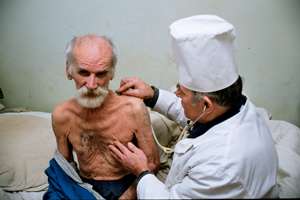
Partners In Health's work in Russia has a narrower medical focus over a vastly wider geographical area than any of its other projects. From a base in the region of Tomsk Oblast, Siberia, PIH has been working since 1998, in collaboration with the Russian Ministry of Health, to combat one of the world's worst epidemics of drug-resistant tuberculosis (MDR-TB).[32] As of 2014, 39,000 Russians had the disease. In partnership with the Division of Social Medicine and Health Inequalities (DSMHI) at the Brigham and Women’s Hospital, PIH has focused on improving clinical services for MDR-TB patients in Tomsk while undertaking training and research to catalyze change in treatment of MDR-TB across the entire Russian Federation.
Partners In Health began working with local clinicians to improve treatment of MDR-TB in Tomsk in 1998. The joint effort got a major boost in 2004, when assisted partners in Tomsk in securing a five-year $10.8 million grant from the Global Fund to Fight AIDS, Tuberculosis and Malaria for efforts to improve prevention, diagnosis and treatment of TB and MDR-TB. Key components of clinical effort include improving diagnostics in order to detect cases earlier, developing a comprehensive strategy to promote adherence among patients, improving infection control in hospitals and clinics and decreasing transmission of TB to HIV-positive patients. Work in Tomsk also encompasses health education for the public and clinical and program management training for medical personnel in Tomsk.[33][34]
Partners In Health operates in two other states in Russia, Voronezh and Karelia, where technical assistance is provided to regional tuberculosis services.
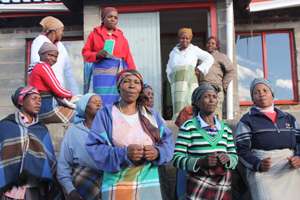
Lesotho
Bo-Mphato Litšebeletsong tsa Bophelo/Partners In Health in Lesotho was PIH's second project in Africa and the first in a country suffering from extremely high prevalence of HIV.[35] Approximately one quarter of Lesotho's adult population is HIV-positive and life expectancy in the tiny mountain kingdom has plummeted to less than 40 years. In addition, the Basotho people are being ravaged by a second epidemic: tuberculosis. Lesotho's TB rate is among the highest in the world, and TB spreads rapidly and is particularly deadly where many people's immune systems are weakened by HIV. The PIH project in Lesotho was launched in 2006 following an invitation from the Lesotho's Ministry of Health and consultation with partners in Rwanda, the Clinton HIV/AIDS Initiative (CHAI, now known as the Clinton Health Access Initiative), about where to replicate that successful model elsewhere in Africa.[36]
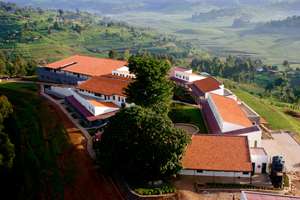
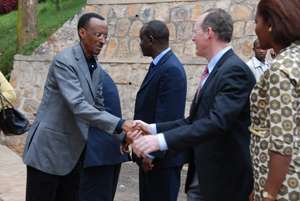
Rwanda
Partners In Health/Inshuti Mu Buzima (IMB) has been working in Rwanda since 2005. In partnership with the Government of Rwanda and the Clinton Health Access Initiative (CHAI), IMB's work supports the Ministry of Health to comprehensively strengthen the public health system in rural, underserved areas of the country. Initially, PIH and CHAI began by implementing a pilot project in two rural districts, Kayonza and Kirehe, in Rwanda’s Eastern Province. Building off of PIH’s approach in Haiti, the project was designed as a comprehensive primary health care model within the public sector. The approach used HIV/AIDS prevention and care as the entry point to build capacity to address the major health problems faced by the local population. Haitian physicians, nurses, and managers traveled to Rwanda extensively in the early years of the program to provide training and program design assistance.
Inshuti Mu Buzima Supported Facilities
In January 2011, PIH supported the Ministry of Health of Rwanda in the opening of Butaro District Hospital.[37][38][39] The hospital, located in Burera district, has 156 beds.
University of Global Health Equity
In September 2015, Partners In Health inaugurated University of Global Health Equity, a non-for-profit organization offering a two-year part-time master’s degree in Global Health Delivery.[40] Construction began in September 2016 on the first phase of a campus,[41] which is expected to be ready in 2018, in time to serve the university’s first cohort of medical students.[42]
Malawi
In early 2007, Abwenzi Pa Za Umoyo (APZU; Partners In Health in Chichewa), started treating patients and training community health workers in the southwestern corner of Malawi, one of the poorest and most densely populated countries in Africa.
The Clinton-Hunter Development Initiative (CHDI) targeted Malawi as a country desperately needing a rural health project to address the devastating HIV/AIDS epidemic in the region. About 14 percent of Malawi's adult population is infected with HIV and hundreds of thousands of children have been orphaned by the disease. CHDI asked Partners In Health to replicate the rural initiative programs that have proven so successful in delivering HIV treatment and comprehensive primary health care in Rwanda and Lesotho. The Malawi Ministry of Health directed PIH and CHDI to the impoverished rural area of Neno.
In 2010, APZU tested 17,606 patients for HIV. The organization clinics logged 332,619 patient visits. APZU supported 889 children, allowing them to attend school and receive food.[43]
Partner Projects
PIH also supports partner projects in the following countries:
- Africa: Project Muso in Mali; Tiyatien Health in Liberia; Village Health Works in Burundi
- Asia: Possible Health in Nepal
- Central America: Equipo Técnico de Educación en Salud Comunitaria in Guatemala
PIH also previously worked in Kazakhstan and the Dominican Republic
See also
References
- ↑ "Tom White, one of Boston's greatest philanthropists, dies". Boston.com. Retrieved 2016-03-23.
- ↑ Kidder, Tracy (2004). Mountains Beyond Mountains: The Quest of Dr. Paul Farmer, a Man Who Would Cure the World. Random House. p. 317. ISBN 978-0-8129-7301-3.
- ↑ Klein, Ezra (2011-08-25). "In Kim, an activist to lead the World Bank". The Washington Post. ISSN 0190-8286. Retrieved 2016-03-23.
- ↑ http://www.pih.org/pages/our-mission
- ↑ Farmer, Paul; Kim, Jim; Kleinman, Arthur; Basilico, Matthew (2013). Reimagining Global Health: An Introduction. California: University of California Press. p. 133. ISBN 9780520271999.
- ↑ Hamblin, James. "The Moral Medical Mission: Partners In Health, 25 Years On". The Atlantic. Retrieved 2016-03-01.
- ↑ Shen, Helen WHTT (2012-07-18). "A boost from Boston in Rwanda's cancer fight". Boston.com. Retrieved 2016-03-01.
- ↑ Ivers, Louise C. (2013-02-22). "A Chance to Right a Wrong in Haiti". The New York Times. ISSN 0362-4331. Retrieved 2016-03-01.
- ↑ Farmer, Paul (2013). To Repair the World: Paul Farmer Speaks to the Next Generation. California: University of California Press. pp. xxvi. ISBN 9780520275973.
- ↑ Griffin, Michael; Block, Jennie Weiss, eds. (2013). In The Company of the Poor: Conversations with Dr. Paul Farmer and Fr. Gustavo Gutierrez. New York: Orbis Books. pp. 52, 64. ISBN 9781626980501.
- ↑ Farmer, Paul E., Bruce Nizeye, Sara Stulac, and Salmaan Keshavjee. 2006. "Structural Violence and Clinical Medicine". PLoS Medicine, 1686-1691.
- ↑ Kidder, Tracy (2004). Mountains Beyond Mountains: The Quest of Dr. Paul Farmer, A Man Who Would Cure the World. Random House. ISBN 978-0-8129-7301-3.
- ↑ Farmer, Paul (2004). Pathologies of Power: Health, Human Rights, and the New War on the Poor. University of California Press. pp. 93, 122, 173. ISBN 9780520243262.
- ↑ "Dr. Paul Farmer on Rwanda's Health Leap, Haiti's Struggles & How Communities Can Repair the World". Democracy Now!. Retrieved 2016-03-23.
- ↑ "Advocacy & Policy". Partners In Health. Retrieved 6 May 2011.
- ↑ "Medical workers gain momentum". Harvard Gazette. Retrieved 2016-03-23.
- ↑ "Dr. Farmer's Remedy For World Health". www.cbsnews.com. Retrieved 2016-03-23.
- ↑ "Sandra Bullock joins celebrity force supporting Haiti relief effort, donates $1 million". NY Daily News. Retrieved 2016-03-23.
- ↑ "Meryl Streep, Drew Barrymore, More Show Support For Haiti At Golden Globes". MTV News. Retrieved 2016-03-23.
- ↑ "Ryan Lewis reveals mother is HIV-positive". NY Daily News. Retrieved 2016-03-23.
- ↑ "Arcade Fire's Win Butler has his own coffee now". www.avclub.com. Retrieved 2016-03-23.
- ↑ "Arcade Fire's Band Aid for Haiti". Mother Jones. Retrieved 2016-03-23.
- ↑ Palazuelos, D.; Ellis, K.; Daeun Im, D.; Peckarsky, M.; Schwarz, D.; Farmer, D. B.; Dhillon, R.; Johnson, A. et al. (2013). "5-SPICE: The application of an original framework for community health worker program design, quality improvement and research agenda setting". Global Health Action 6: 19658. doi:10.3402/gha.v6i0.19658. PMC 3617878. PMID 23561023
- ↑ "Hôpital Universitaire de Mirebalais". Partners In Health. Retrieved 28 August 2014.
- ↑ http://www.pih.org/pages/mirebalais
- ↑ Nicholas Clark Architects. "Mirebalais Hospital". Mirebalais Hospital. Retrieved 11 May 2011.
- 1 2 3 "Peru". Partners In Health. Retrieved August 29, 2016.
- ↑ "TB Patients That The World Writes Off Are Getting Cured In Peru". NPR. Retrieved 2016-03-23.
- ↑ "Peru: Study Aims to Reveal How TB Spreads". www.pih.org. Retrieved 2016-05-02.
- ↑ Ronny Isla Isuiza (August 3, 2011). "EE.UU. patrocina ambiciosa investigación sobre la transmisión de la TBC en el Perú". El Comercio Peru. Retrieved August 29, 2016. English
- ↑ "PIH Mexico Expands to Two New Sites in Chiapas". www.pih.org. Retrieved 2016-05-02.
- ↑ "'Sputnik' Orbits A Russian City, Finding And Healing Tuberculosis". NPR.org. Retrieved 2016-03-23.
- ↑ Partners In Health. "Russia". PIH-Russia. Retrieved 11 May 2011.
- ↑ Splete, Heidi. "Partners In Health Treats TB in Russia". Partners In Health Treats TB in Russia. Hospital News Digital Network. Retrieved 11 May 2011.
- ↑ "HIV and AIDS in Lesotho". Retrieved 11 October 2016.
- ↑ Partners In Health. "Lesotho". PIH. Retrieved 6 May 2011.
- ↑ Partners In Health. "FROM NO DOCTORS TO THE "FINEST HOSPITAL IN CENTRAL AFRICA". PIH. Retrieved 6 May 2011.
- ↑ Philp, Rowan. "Rwanda's Medical Miracle". The Times (South Africa). Retrieved 6 May 2011.
- ↑ Kagire, Edmund. "Kagame opens new hospital in Butaro". New Times (Rwanda). Retrieved 6 May 2011.
- ↑ Kantegwa, Sharon. "New university to integrate development into health sector". The New Times Rwanda. Retrieved 2016-10-24.
- ↑ Nkurunziza, Michel (2016-09-07). "Rwanda: Construction of U.S.$150 Million University Starts in Burera". Rwanda Focus (Kigali). Retrieved 2016-10-24.
- ↑ "Medical Education and Global Health Equity". The AMA Journal of Ethic. 18 (7): 702–709. 2016-07-01. doi:10.1001/journalofethics.2016.18.7.medu1-1607.
- ↑ Partners In Health. "Annual Report 2010". Annual Report 2010: Malawi. Retrieved 9 May 2011.
External links
- Partners In Health
- A Conversation with Tracy Kidder about Mountains Beyond Mountains by Mark Klempner, 2008.
